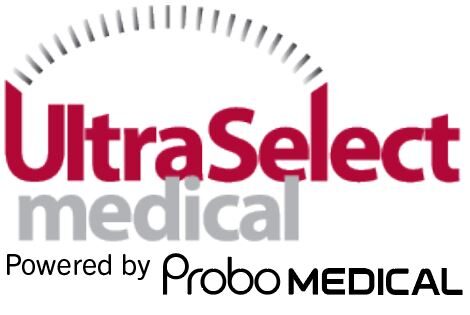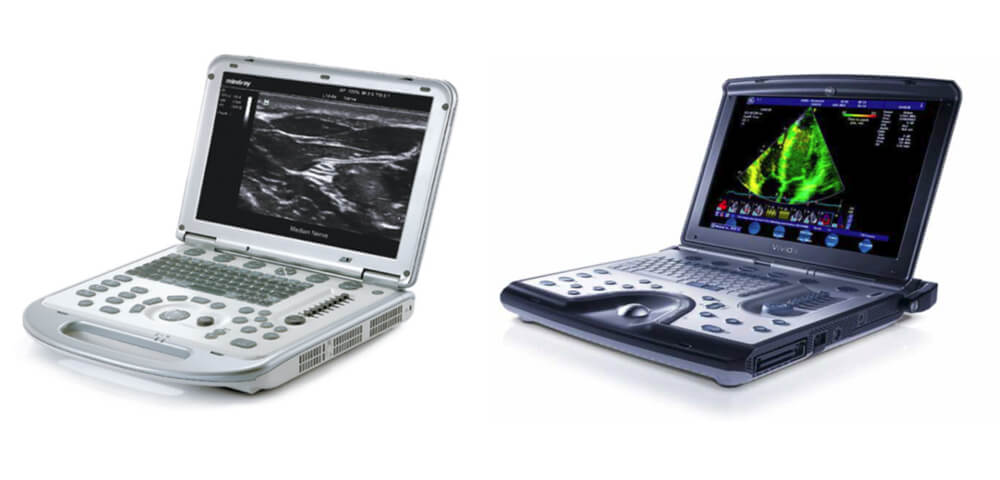When it comes to machine purchase the choices are endless. If you are looking at these two machines then price is your primary concern. Trying to balance the price with the image quality will be easy here. There are times when the GE user would need to consider the Mindray system. This guide should provide you with the facts and features of each machine to help you make a decision.
GE Vivid i
This system is for cardiovascular, abdominal, small parts, perioperative monitoring and 2D ICE exams. The basis for the platform is GE’s TruScan Architecture. This means that the workstation, software and network solutions are seamless. This unit has a software-driven PC based platform, raw data storage with advanced post-processing capabilities are innovative tools to allow for fast DICOM transfer.
For the general 2D imaging the Vivid I features a probe specific 30cm depth range, Harmonic tissue imaging on all linear and convex probes and Coded Phase Inversion for increased levels of contrast resolution. For speckle reduction and clarity GE offers the UD Clarity and UD Speckle to better imaging. The cardiac imaging boasts six levels of harmonics and ultra-high frame rates. Coded Octave Imaging is a second generation tissue imaging tool that provides better spatial and contrast resolution. You can see that there are many extras in this machine for image quality.
This unit has standard trackball steerable m-mode and anatomic m-mode with digital replay. The color flow Doppler uses digital signal processing to maintain a high frame rate with large ROI’s even with low PRF’s. For the customer’s convenience there is a Smart Depth Color option for increased ease of scanning. B flow and BFI are options for hemodynamics. Both Color Angio and Color M-Mode are available and standard issue. Pulsed wave and High PRF Doppler come standard on this unit. CW Doppler is very sensitive and steerable and comes on all phased array and pencil probes.
If size is of concern then you have a good choice. The depth is 13.0inches including the handle, the width measures 14.2 inches and the height is 2.5inches. The weight of the portable is 12.7lbs without the battery. This fits on the Safelock Cart and that comes with four swivel wheels with four brakes, one probe and one gel holder, two shelves, three AC outputs, four USB ports and is height adjustable.
There are a rich array of probes that fit the Vivid i. Six phased array probes cover any echo need you may have. Three linear probes many imaging modes. Two convex (curved) array probes along with the e8C-RS probe allows for the option of the OB package. Then there is the i12L-RS for intraoperative scanning, two Doppler pencil probes, two multiplane transesophageal transducers and three Intra-Cardiac echo (ICE) catheters that complete the roster.
Mindray M7
This system is designed for fully functional shared service. Each specialty package comes ready with exam mode, comments, measurements, body marks and reports. Mindray’s research and development used a System on Chip design for this M7 platform. This allows faster response time and allows for complex processes to provide the user with a faster and more versatile experience. This technology holds many components of a computer but is much smaller and lighter and it uses less power. This unit also has raw data storage and fast DICOM transfer.
There are a number of technologies in this machine that are used for the general 2D imaging to improve the image. The M7 uses octal beam technology to improve temporal resolution. Then there are the three buttons the operator can change to enhance the images. iBeam, iClear and iTouch are all innovations for spatial compounding, speckle reduction and one touch image control for 2D, PW and CW. There are also multi-level harmonics for image advancement. With all these factors you have great image quality.
This ultrasound machine comes with standard M-Mode. There is Free XROSm (anatomical m-mode) that is freely moveable and can employ color M- mode as well. Power Doppler also comes standard and is very sensitive. There is the standard color flow Doppler, pulsed wave Doppler and directed CW on the phased array probes and pencil probe. TVI is also standard. B Flow is not on this machine. 3D/4D is an option with the correct probes.
This unit is slightly larger than the Vivid i. The depth is 14.06inches with handle. The width is 14.21inches and the height is 2.95inches. The weight is 14.33lbs. This comes with two choices of carts, the UMT-200 or the UMT-300. Both have four wheels and brakes. There are four transducer holders and one gel holder. The USB ports are located in the M7 unit itself. UMT 200 and 300 are both height adjustable with power supply and isolation transformer. The ECG module is one that you need to attach to the back of the unit.
There is one convex probe and four linear probes for a variety of applications. Two sector phased arrays are good options for cardiac and transcranial imaging. Lastly the two intracavitary transducers round out the lineup. Most of these probes have biopsy guides for those procedures that need them.
Then there is the cost of the two units.
Since the Vivid i stopped production in 2014, they only come used. The differences between used and refurbished will not be discussed here as this was the subject of another blog. The Mindray M7 comes new with a five year warranty.
With the the Mindray you get the newest technology and the new upgrades (ever living technology). For example, when you export the studies you now have a choice between JPEG, AVI, TIFF and the GE you can only export in MPEGVue. Also the customization of presets and measurements are easier on the Mindray than the GE. This is a very important point because you want to be able to have the widest diagnostic range for the money.
All things considered you can get a brand new Mindray for about the same as a used GE. What is not to like about that?


